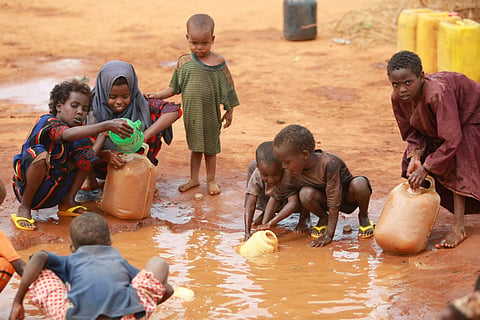

Ecological threats, including climate change, food insecurity and water scarcity are increasingly recognised as significant factors that affect the dynamics of an armed conflict.
Without concerted international action, ecological degradation will continue to accelerate, intensifying a range of social issues, including malnutrition and forced migration.
At present 1.3 billion people facing high or very high levels of ecological threat reside in 50 countries, according to a report by an international think tank named Institute for Economics and Peace (IEP). According to the report, investment in water and agricultural infrastructure is urgently needed to tackle the climate crisis.
The Ecological Threat Report (ETR) identified 27 ecological hotspots, where countries facing high ecological risks intersect with low societal resilience.
Of the 27 hotspot countries, 19 are in sub-Saharan Africa and four in the Middle East and North Africa and the remaining four spread across Asia and the Caribbean.
The report’s briefing, prepared specifically ahead of COP29, distilled the key findings of the ETR into actionable insights.
The briefing covers three key themes relevant to COP29’s focus on climate finance — the opportunity for targeted climate finance to yield transformative results; the critical role of water capture and agricultural enhancement in preventing conflict; and the compelling economic case for preventive investment.
This briefing demonstrated how targeted investments in ecological resilience can yield outsized returns in stability and security.
It is no surprise that sub-Saharan Africa bears an increasingly heavy burden from climate change.
In the next 26 years, the population of sub-Saharan Africa is projected to nearly double, from 1.2 billion in 2024 to 2.1 billion in 2050.
In contrast, the population of the rest of the world is projected to grow by only about 10 per cent.
Sub-Saharan Africa’s growth will shift its current rural-urban balance. At present, 44 per cent of the population live in urban settings, making it one of just two regions in the world that continues to be predominantly rural. However, by 2050 it will be urban majority, with 58 per cent of the population projected to live in towns and cities.
While rural populations in all other regions of the world will either shrink or remain virtually unchanged, sub-Saharan Africa’s rural population will grow by 32 per cent in the next two and a half decades.
Sub-Saharan Africa has the lowest crop yields of any region in the world. Farms in the region produce an average of about 1.7 tonnes of cereals per hectare each year, less than a third of the global average of 5.4 tonnes per hectare.
The region has both unused arable land and large and under-utilised water resources.
The greatest obstacle to increased water utilisation for agriculture in sub-Saharan Africa is the lack of infrastructure to effectively capture and distribute water, particularly during dry seasons.
Currently, only two per cent of the region’s renewable water resources are used in agriculture, less than one third of the global rate of 6.7 per cent and substantially less than the 47.7 per cent used in the Middle East and North Africa.
According to FAO data, sub-Saharan Africa has about 34.2 million hectares of farmland that is not irrigated.
The Institute for Economics and Peace (IEP) estimates that providing adequate water to fully utilise these lands would cost about US$9.2 billion per annum and result in average yield increases of about 80 per cent, which would have a total annual value of at least US$12.3 billion.
The analysis shows that an annual investment of USD $15 billion in water capture and agricultural enhancement initiatives could increase food production in sub-Saharan Africa by 50 per cent by 2050.
As COP29 considers the complex challenge of climate finance, this analysis presents one practical opportunity for immediate action.
“The choice before us is clear. We can invest now in proven solutions like micro water capture and agricultural enhancement, or we can pay many times over in addressing the consequences of inaction. As you engage in-person, online or around the world during COP29, I urge you to consider how the insights from this briefing might inform your approach to climate finance. The solutions are within our reach – we need only the collective wisdom and will to implement them,” Steve Killelea AM, Founder & Executive Chairman Institute for Economics & Peace said.